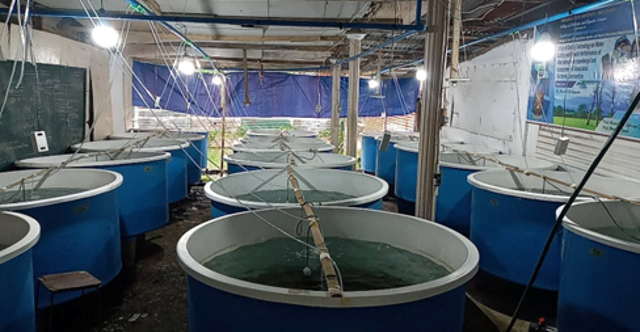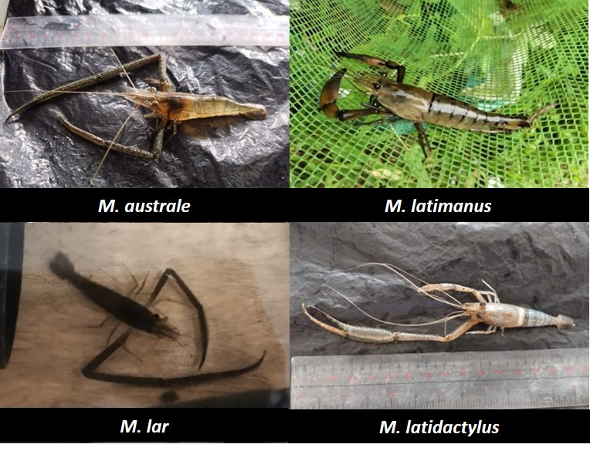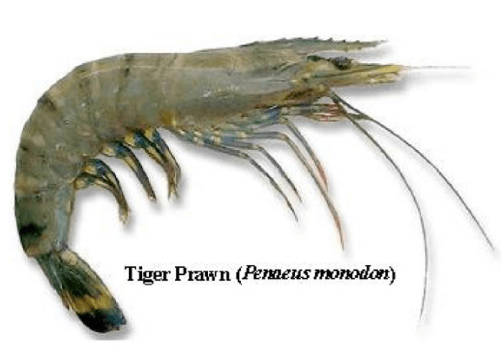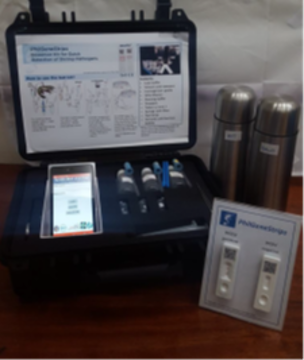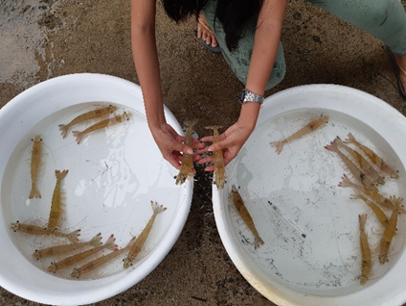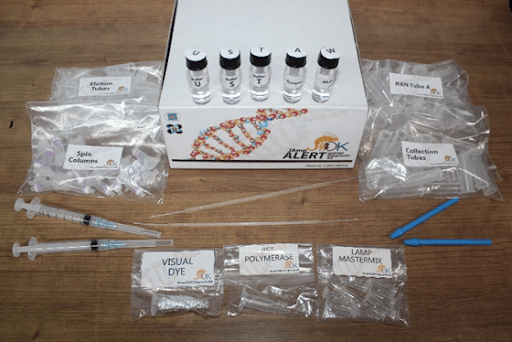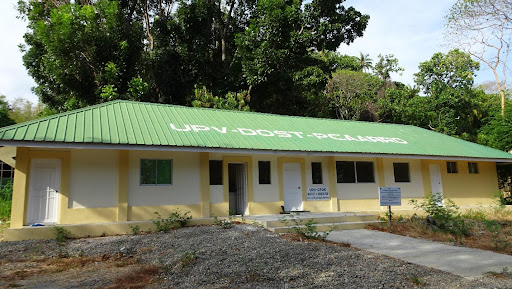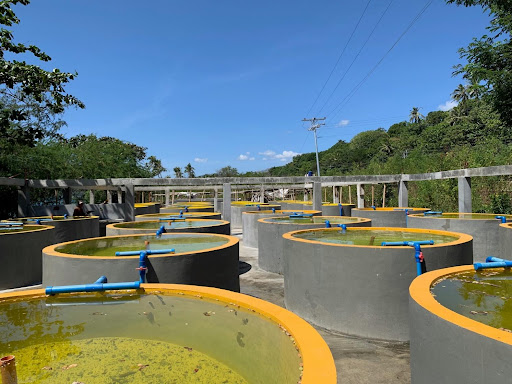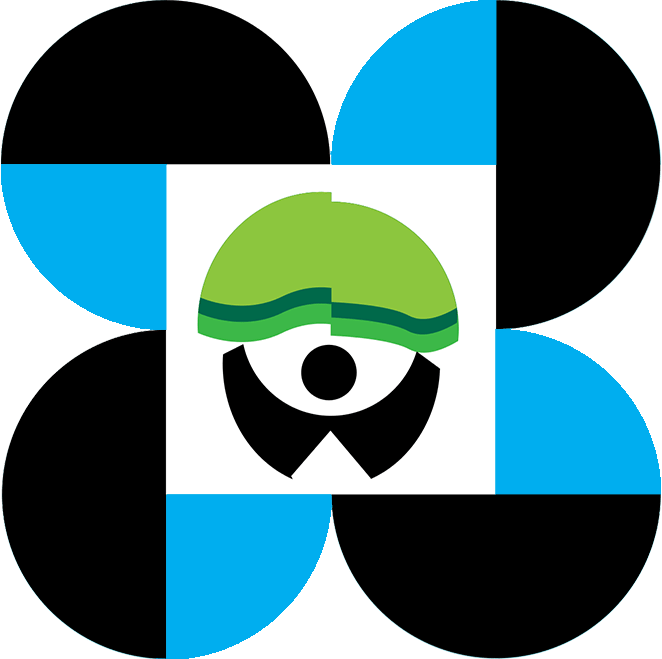Shrimp
Industry Strategic Science and Technology Program
Shrimp Industry Profile
The shrimp industry is an important component of the aquaculture sector in the Philippines. Shrimps are sold fresh and whole, frozen or processed into shrimp powder, paste or sauce. Shrimp started as an incidental harvest in brackish water ponds before its production boom in the mid-1980. However, the Philippine shrimp industry underwent a decline in production. In 2020, the total shrimp/prawn production was 70,474.77 MT with the leading species black tiger shrimp’s production of 42,452.94 MT and pacific white or whiteleg shrimp’s production of 20,632.89 MT. Other recorded species are endeavor prawn, white shrimp and freshwater shrimp.
The black tiger shrimp, which ranges from 9 to 11 inches, is the largest shrimp species. Aside from its size, it can also be identified by the black stripes on its back and tail. The whiteleg shrimp, on the other hand, generally has translucent white in color and can grow up to 9 inches.
Problems in the Industry
Farmed shrimps, particularly the black tiger shrimp or “sugpo” is an important foreign exchange earner until production dropped due to disease outbreaks and difficulty faced in recovery. Of foremost threat is the White Spot Syndrome Disease Virus which causes high shrimp mortality and economic losses. Other issues faced by the industry are low production yield, high cost of broodstock (P. vannamei), and unavailability of good quality local breed/strain both for P. vannamei and P. monodon.
Data Source: Philippine Statistics Authority update as of May 30, 2024.
Data Source: Philippine Statistics Authority update as of May 30, 2024.
Shrimp Policies
| Policy Type | Policy Number | Policy Year | Congress | Policy Title | Policy Description | Policy Objective | Policy Link | Commodity | Classification | info_encoder_stamp | info_date_stamp | info_quashing_remarks | filepath |
|---|---|---|---|---|---|---|---|---|---|---|---|---|---|
| Bill | House Bill No. 8681 | 2023 | 19th | An Act Establishing A Multi-Purpose Fishery Breeding Farm And Hathery For The Production And Multiplication Of Crabs, Shrimps And Milkfish In The Municipality Of Balud, Province Of Masbate, And Appropriating Funds Therefor | According to the officials from the Bureau of Fisheries and Aquatic Resources (BFAR) in the Province of Masbate, there are atleast 2,000 hectares in the coastal areas of Masbate that are desolate until now. The establishment of such breeding farm and hatchery will greatly improve the economic lives of the people not only in the above-mentioned area but also in the entire province of Masbate. It will also provide excellent employment opportunities and help alleviate poverty. In addition, the farm and hatchery will help replenish the supply of crabs, shrimps and milkfish there and will enable the people to keep pace with the increasing demand for these marine products, locally and even worldwide. | This bill seeks to establish a multi-purpose fishery breeding farm and hatchery for the production of crabs, shrimps, and milkfish in the Municipality of Balud, Province of Masbate, to meet the nutritional and economic needs specifically of the residents of the coastal barangays of Balud. The people of these coastal town rely upon fishing as their sources of food and livelihood. | https://docs.congress.hrep.online/legisdocs/basic_19/HB08681.pdf | Shrimp | Null | Jeff | 11/22/2024 | C:\Users\trist\Documents\Formatting\Output\Shrimp_2024-11-22_processed.xlsx | |
| Bill | House Bill No. 8680 | 2023 | 19th | An Act Establishing A Multi-Purpose Fishery Breeding Farm And Hathery For The Production And Multiplication Of Crabs, Shrimps And Milkfish In The Municipality Of Mandaon, Province Of Masbate, And Appropriating Funds Therefor | Officials from the Bureau of Fisheries and Aquatic Resources (BF AR) in the Province of Masbate revealed that there are atleast 2,000 hectares in the coastal areas of Masbate that are desolate until now. The establishment of such breeding farm and hatchery will greatly improve the economic competitiveness and lives of the people not only in the above-mentioned area but also in the entire province of Masbate. It will also provide excellent employment opportunities to local fishermen and help alleviate poverty. In addition, the farm and hatchery will help replenish the supply of crabs, shrimps and milkfish there and will enable the people to keep pace with the increasing demand for these marine products, locally and even worldwide. | This bill seeks to establish a multi-purpose fishery b1·eeding farm and hatchery for the production of crabs, shrimps and milk.fish in the Municipality of Mandaon, Province of Masbate, to meet the nutritional and economic needs specifically of the residents of the coastal barangays of Mandaon. The people of these coastal town rely upon fishing as their source of food and livelihood. | https://docs.congress.hrep.online/legisdocs/basic_19/HB08680.pdf | Shrimp | Null | Jeff | 11/22/2024 | C:\Users\trist\Documents\Formatting\Output\Shrimp_2024-11-22_processed.xlsx | |
| Bill | House Bill No. 7501 | 2023 | 19th | An Act Establishing A Multi-Species Marine Hatchery To Include The Production Of Crabs, Shrimps And Lobsters In The Municipality Of Sta. Cruz, Province Of Davao Del Sur, And Appropriating Funds Therefor | SECTION 1. There shall be established, under the supervision of the Bureau of Fisheries and Aquatic Resources of the Department of Agriculture (DA-BFAR), a multi-species marine hatchery in the Municipality of Sta. Cruz, Province of Davao del Sur. SEC. 2. Prior to the establishment of the multi-species marine hatchery, the DA-BFAR shall conduct a full-scale feasibility study in support of its construction to comply with the requirements of the Department of Budget and Management. Within two (2) years after the construction of the multi-species marine hatchery, the DA10 BFAR, through a memorandum of agreement, shall transfer its management to the local government of the Municipality of Sta. Cruz. It shall implement a training and phasing-in program for local government personnel on the management and operation of the hatchery. SEC. 3. The DA-BFAR shall conduct continuing research and experimentation on the breeding and production of marine species, including the production of crabs, shrimps and lobsters, especially as they apply to local conditions, to discover new methods and technologies that will enhance the fishing industry. SEC. 4. The Secretary of Agriculture shall include in the Department’s programs the conduct of the feasibility study and the consequent establishment of the multi-species marine hatchery in the Municipality of Sta. Cruz, Province of Davao del Sur, the funding of which shall be included in the General Appropriations Act. The local government unit concerned shall set aside funds from any available local revenue in an amount deemed appropriate for the operationalization of the hatchery. | This bill aims to establish a multi-species marine hatchery under the supervision of the Bureau of Fisheries and Aquatic Resources of the Department of Agriculture (DA-BFAR) in the municipality of Sta. Cruz, Province of Davao del Sur. | https://docs.congress.hrep.online/legisdocs/third_19/HBT7501.pdf | Shrimp | Null | Jeff | 11/22/2024 | C:\Users\trist\Documents\Formatting\Output\Shrimp_2024-11-22_processed.xlsx | |
| Bill | House Bill No. 3068 | 2022 | 19th | An Act Establishing Multi-Purpose Fish Breeding Farms And Hatcheries For The Production Of Crabs, Shrimps And Lobsters In The Province Of Davao Del Sur, Appropriating Funds Therefor | SECTION 1. There shall be established, under the supervision of the Bureau of Fisheries and Aquatic Resources of the Department of Agriculture, multi-purpose fish breeding fam1s and hatcheries for the production and multiplication of crabs, shrimps, and lobsters in the Province of Davao Del Sur. SEC. 2.The Bureau of Fisheries and Aquatic Resources of the Department of Agriculture shall conduct continuing research and development on the production of crab, shrimp, and lobster culture, especially as they apply to local conditions, and discover new methods and technologies that will improve the fishing industry. SEC. 3. The Secretary of Agriculture shall include in the Department's programs the establishment of multi-purpose fish breeding farms and hatcheries for the production and multiplication of crabs, shrimps, and lobsters in the Province of Davao Del Sur, the funding of which shall be included in the annual General Appropriations Act. Thereafter, such sum as may be necessary for the operations of the multi-purpose fish breeding fanns and hatcheries shall be included in the annual budget of the Department of Agriculture Davao Del Sur Provincial Office. | This bill seeks to establish a multi-purpose fish breeding farms and hatcheries for the production and multiplication of crabs, shrimps, and lobsters as a practical and sustainable solution to the growing demand. The rearing of fry and fingerlings will help increase the supply of these aquatic resources, provide sustainable livelihood to our fisherfolks, and boost the trade of marine products in Davao Del Sur. | https://docs.congress.hrep.online/legisdocs/basic_19/HB03068.pdf | Shrimp | Null | Jeff | 11/22/2024 | C:\Users\trist\Documents\Formatting\Output\Shrimp_2024-11-22_processed.xlsx | |
| Bill | House Bill No. 9638 | 2021 | 18th | An Act Establishing Multi-Purpose Fish Breeding Farms And Hatcheries For The Production Of Crabs, Shrimps And Lobsters In The Province Of Davao Del Sur, Appropriating Funds Therefor | Davao Del Sur is endowed with an abundance of coastal natural resources and its residents has long depended on its fisheries, coral reefs, mangroves, beaches, coastal bays, and estuaries for aquaculture and other uses. The Philippine Statistics Authority Fisheries Situationer Report for the first quarter of 2019 stated that the Province of Davao Del Sur has shown substantial contribution in the production of aquaculture at 68.51 percent of the recorded total of 7,956.33 metric tons. However, the rapid growth of the communities and increasing demands of aquatic products for consumption and trade poses a direct problem to the supply of these products and is therefore in need of government intervention. | This bill seeks to establish a multi-purpose fish breeding farms and hatcheries for the production and multiplication of crabs, shrimps, and lobsters as a practical and sustainable solution to the growing demand. The rearing of fry and fingerlings will help increase the supply of these aquatic resources, provide sustainable livelihood to our fisherfolks, and boost the trade of marine products in Davao Del Sur. | https://docs.congress.hrep.online/legisdocs/basic_18/HB09638.pdf | Shrimp | Null | Jeff | 11/22/2024 | C:\Users\trist\Documents\Formatting\Output\Shrimp_2024-11-22_processed.xlsx | |
| Bill | House Bill No. 9632 | 2021 | 18th | An Act Providing For The Construction Of Solar Pavement Dryers For Seaweeds, Fish, Squid, Shrimp And Other Marine Products In All Suitable Municipalities In The Province Of Davao Del Sur And Appropriating Funds Therefor | The Philippine Statistics Authority Fisheries Situationer Report for the first quarter of 2019 stated that the Province of Davao Del Sur has shown substantial contribution in the production of aquaculture at 68.51 percent of the recorded total of 7,956.33 metric tons. However, the COVID-19 pandemic in 2020 has greatly affected key activities in the fisheries or aquaculture supply chain, disrupted by impacts arising from Covid-19 and other related government measures. Seaweeds, fish, squid, shrimp and other marine products are highly perishable produce, and such disruptions in the transportation and distribution supply chain due to the pandemic have gravely affected the economic situation of fisherfolks and the food security of the citizenry. The aquaculture production sector is extremely diverse, both freshwater and marine, but it nevertheless relies heavily on labor, inputs, financing and markets, which have been and will continue to be impacted during and after the COVID-19 pandemic. To protect the aquaculture producers in the Province of Davao Del Sur from losses and help modernize post-harvest processes, this representation proposes the construction of solar pavement dryers for seaweeds, fish, squid, shrimp and other marine products in all suitable municipalities in the Province. Solar assisted drying is one of the most promising post handling process of agricultural produce as it can improve the quality and extend the shelf life of these products, improve the bargaining position of the fisherfolks, reduces post-harvest losses, and lower transportation costs. | This bill proposes the construction of solar pavement dryers for seaweeds, fish squid, shrimp and other marine products in all suitable municipalities in the province of Davao del Sur to protect the aquaculture producers from losses and help modernize post-harvest processes. | https://docs.congress.hrep.online/legisdocs/basic_18/HB09632.pdf | Shrimp | Null | Jeff | 11/22/2024 | C:\Users\trist\Documents\Formatting\Output\Shrimp_2024-11-22_processed.xlsx | |
| Bill | House Bill No. 4627 | 2019 | 18th | An Act Establishing Multi-Purpose Fish And Shrimp Hatcheries In All Suitable Areas In The First District Of The Province Of Bataan And Appropriating Funds Therefor | The First Congressional District of the Province of Bataan is composed of the coastal municipalities of Abucay, Hermosa, Morong, Orani, Samal, and a landlocked Dinalupihan. The District has combined land area of 66,962 hectares and is home to approximately 344,000 based on the 2015 Philippines Statistics Authority Report. The hatcheries will contribute to the existing agro/aqua-tourism sites in the District. In fact, there is an existing Philippine National Aquasilviculture program implemented by the Bataan Peninsula State University (BPSU) to rehabilitate denuded mangrove resources, establish aquasilviculture technology demonstration projects as a livelihood option for fisherfolks (while caring for the mangroves they had planted), and establish community-based multi-species hatcheries to increase endemic fish species in the area. | This bill seeks to establish fish and shrimp hatcheries in all suitable areas in the District to catalyze the development of aquaculture in the municipalities which can provide both direct and indirect employment for its people. | https://docs.congress.hrep.online/legisdocs/basic_18/HB04627.pdf | Shrimp | Null | Jeff | 11/22/2024 | C:\Users\trist\Documents\Formatting\Output\Shrimp_2024-11-22_processed.xlsx | |
| Bill | House Bill No. 2408 | 2019 | 18th | An Act establishing Multipurpose Fish and Shrimp hatcheries In All Suitable Areas In The First District Of The Province Of Nueva Ecija, and Appropriating Funds Therefor | SECTION 1. There shall be established, under the supervision of the Bureau of Fisheries and Aquatic Resources of the Department of Agriculture (BFAR-DA), multipurpose fish and shrimp hatcheries in all suitable areas in the First District of the Province of Nueva Ecija. SECTION 2. Within two (2) years after the construction of the multipurpose fish and shrimp hatcheries, the BFAR-DA, through a memorandum of agreement, shall transfer the management of the hatcheries to the local government units concerned. It shall implement a training and phasing-in program for local government personnel on the management and operation of the hatcheries. SECTION 3. The Secretary of Agriculture shall include in the Department's programs the establishment of the multipurpose fish and shrimp hatcheries, the funding of which shall be included in the annual General Appropriations Act. The local government units concerned shall set aside funds from any available local revenue in an amount deemed appropriate for their operationalization. | This bill seeks to establish multipurpose fish breeding stations as well as shrimp hatcheries in the 1st District of the Province of Nueva Ecija. The objective is to teach and employ constituents in the science of breeding shrimps and inland fishes for the purpose of harnessing the aquatic natural resources of the locality. When properly implemented, the venture will not only be capable of improving the district's, even the province's economy, it will also play a part in the establishment of an industry that is invaluable to the national economy. | https://docs.congress.hrep.online/legisdocs/basic_18/HB02408.pdf | Shrimp | Null | Jeff | 11/22/2024 | C:\Users\trist\Documents\Formatting\Output\Shrimp_2024-11-22_processed.xlsx | |
| Bill | Senate Bill No. 2905 | 2018 | 14th | An Act Establishing Multi Purpose Fish Breeding Stations And Crab, Prawn And Shrimp Hatcheries In All Suitable Areas In The Province Of Tawi-Tawi And Appropriating Funds Therefor | SECTION I. There shall be established, under the supervision of the Bureau of Fisheries and Aquatic Resources of the Department of Agriculture, multi-purpose fish breeding stations and crab, prawn and shrimp hatcheries in all suitable areas in the Province of Tawi-Tawi. SEC. 2. The Bureau of Fisheries and Aquatic Resources shall conduct continuing research and experimentation on fish, crab, prawn and shrimp culture especially as they apply to local conditions, for the purpose of improving existing technology and for maximizing income potentials of the fishing industry. SEC. 3. The Secretary of Agriculture shall include in the Department's program, the establishment and operationalization of the multi-purpose fish breeding stations and crab, prawn and shrimp hatcheries in all suitable areas in the Province of Tawi-Tawi, the funding of which shall be included in the annual General Appropriations Act. | This bill seeks to provide for the establishment of multi-purpose fish breeding station and crab, prawn and shrimp hatchery in all suitable areas in the Province of Tawi-Tawi. Tawi-Tawi is rich in fishery and other marine resources. With appropriate technologies, the people can benefit more from the richness of the sea and its growth potential can be optimized. | https://legacy.senate.gov.ph/lisdata/94678573!.pdf | Shrimp | Null | Jeff | 11/22/2024 | C:\Users\trist\Documents\Formatting\Output\Shrimp_2024-11-22_processed.xlsx | |
| Republic Act | Republic Act No. 9459 | 2007 | 13th | An Act To Establish An Oyster, Mussel, Crab, Prawn And Shrimp Farm In The Municipality Of Calabanga, Province Of Camarines Sur, Appropriating Funds Therefor And For Other Purposes | SEC 3. The Department of Agriculture, through the oyster, mussel, crab, prawn and shrimp farm, is hereby authorized to conduct such researches and experiments as may be necessary to improve existing technology on oyster, mussel, crab, prawn and shrimp and such other marine and aquatic animals farming and to enhance and maximize income potentials of said industry. The Department shall assist the local government to establish, in appropriate locations, their own oyster, mussel, crab, prawn and shrimp farms as pilot demonstration farms or as economic enterprises for local revenue generating purposes. SEC 4. The Secretary of Agriculture shall include in the Department’s program the funding requirements for the establishment and operationalization of the oyster, mussel, crab, prawn and shrimp farm in the Municipality of Calabanga, Province of Camarines Sur. Thereafter, such sum as may be necessary for its continued operation and maintenance shall be included in the annual General Appropriations Act. | This aims to establish an oyster, mussel, crab, prawn and shrimp farm in the Municipality of Calabanga, Province of Camarines Sur, which shall be udner the supervision and control of the Bureau of Fisheries and Aquatic Resources of the Department of Agriculture. | https://www.officialgazette.gov.ph/2007/05/15/republic-act-no-9459/ | Shrimp | Null | Jeff | 11/22/2024 | C:\Users\trist\Documents\Formatting\Output\Shrimp_2024-11-22_processed.xlsx | |
| Proclamation | Proclamation No. 541, s. 1969 | 1969 | Null | Reserving For Demonstration Fish Farm, Bangus Fry Nursery, Shrimp Culture Laboratory And Oyster Farm Purposes Certain Parcels Of Land Of The Public Domain Situated In The Municipality Of Virac, province Of Catanduanes | The land herein reserved shall be subject to the provisions of Republic Act No. 2056 and Executive Order No. 113, series of 1955 and to the conditions that a 40-meter wide strip of land along the bank of the Sto. Domingo River shall be demarcated and preserved as permanent timberland for bank protection purposes pursuant to the provisions of Republic Act 1273 and as adequate waterway during flood stages and working space for the maintenance and improvement of the river channel for flood control and drainage purposes. | This aims to reserve for demonstration fish farm, bangus fry nursery, shrimp culture laboratory and oyster farm purposes, subject to private rights, if any there be certain parcels of land of the public domain in the municipality of Virac, province of Catanduanes. | https://www.officialgazette.gov.ph/1969/03/25/proclamation-no-541-s-1969/ | Shrimp | Null | Jeff | 11/22/2024 | C:\Users\trist\Documents\Formatting\Output\Shrimp_2024-11-22_processed.xlsx | |
| Proclamation | Proclamation No. 182, s. 1967 | 1967 | Null | Reserving For Shrimp Culture Project Site Purposes A Portion Of Public Marshy Land, Situated In The City Of Ozamis, Province Of Misamis Occidental, Island Of Mindanao, Under The Administration Of The Commission On Fisheries. | Upon the recommendation of the Secretary of Agriculture and Natural Resources and pursuant to the provisions of Section 73 of Act No. 4003, I, FERDINAND E. MARCOS, President of the Philippines, do hereby reserve for shrimp culture project site purposes and for such purposes as would develop the shrimp industry, under the administration of the Fisheries Commission, subject to private rights, if any there be, a certain portion of land of the public domain situated in the City of Ozamis, Province of Misamis Occidental, Island of Mindanao, which land is more particularly described as follows: A parcel of land, portion of Lot 4828 of the Misamis Cadastre, situated in the Barrio of Malaubang, City of Ozamis, Province of Misamis Occidental. Bounded on the South along line 1-2 by Matun–og Creek; on the Northwest along line 2-4 by Fishpond of Pilar Engracia (remaining portion); on the East along 4-1 by Malaubang river. Beginning at a point marked “1” on the plan, being S57-10W 1795.08 M. from B.B.M No. 3, Misamis Cadastre; thence N. 82-03W 94.89 M. to cor. 2; thence N. 7-49E 114.10 M. to cor. 3; thence S. 82-03W 86.89 M. to cor. 4; thence S. 7-49W 91.10 M. to cor. 5; thence S. 11-20E 24.38 M. to the point of beginning, containing an area of TEN THOUSAND SEVEN (10,007) SQUARE METERS, more or less. | This aims to reserve for shrimp culture project site purposes ad for such purposes as would develop the shrimp industry. | https://www.officialgazette.gov.ph/1967/03/15/proclamation-no-182-s-1967/ | Shrimp | Null | Jeff | 11/22/2024 | C:\Users\trist\Documents\Formatting\Output\Shrimp_2024-11-22_processed.xlsx |
ISP for Shrimp
The PCAARRD Shrimp Industry Strategic S&T Program aims to revive the shrimp industry by providing solutions to the perennial problem of disease occurrence. The ISP further aims to increase the yield in pond systems for the black tiger shrimp (Peneaus monodon), whiteleg shrimp (Peneaus vannamei) and the Macrobrachium sp. It also aims to improve feed conversion ratio in commercial farms.
Strategic R&D
Strategic R&D is DOST-PCAARRD’s banner program comprising all R&D activities that are intended to generate outputs geared towards maximum economic and social benefits
This project will investigate the potential role of Type VI Secretion System encoded by Vibrio-causing AHPND during shrimp infection. It has been shown that AHPND...
Biofloc technology has become a popular technology in the farming of tilapia, Penaeus monodon, and Litopenaeus vannamei. It is an advanced technology identified for solving...
This project aims to assist the shrimp industry by developing quality control materials for microbiological testing laboratories in the country. It is recognized that laboratory...
Among the recorded nine (9) naturally-occurring Macrobrachium species in Marinduque, there are 4 species with potentials for culture for their size, including M. australe, M....
Due to various human interventions like overexploitation, environmental pollution and habitat loss, the natural population of Macrobrachium species is declining. There is also a great...
This project falls under the CRADLE Challenge 2020 that aims to revitalize various sectors of the industry as they cope with the devastating effects of...
This project will contribute in providing scientific-based technical strategies of improving the culture condition in P. monodon ponds using eco-based methods of production. This study...
The success of any selective breeding program relies on the genetic diversity of the founder lines so that the selection progresses forward without the negative...
Shrimp aquaculture is considered globally as an economically important industry, providing a major source of livelihood especially in countries with large coastal areas such as...
The program titled “Tiger Shrimp (Penaeus monodon) Genomics Program” is composed of the following projects: Project 1. Mass production of dsRNA to mitigate WSSV infection...
The program titled “Development of Diagnostic Tools through Genomics and Establishment of the Philippine Shrimp Pathogen Biobank and On-line Biosurveillance and Information Resource” is composed...
The program titled “Integrated and Sustainable Development Program for the Shrimp Industry” is composed of the following projects: Project 1. Development of techniques for the production...
Technologies
Products, equipment, and protocols or process innovations developed to improve productivity, efficiency, quality, and profitability in the agriculture and aquatic industries, and to achieve sustainable utilization and management of natural resources
To address the decrease in shrimp production and adaptation to the fast-evolving demands of the new normal due to the COVID-19 pandemic, the University of...
The success of any selective breeding program relies on the genetic diversity of the founder lines so that the selection progresses forward without the negative...
The University of Santo Tomas led by Dr. Mary Beth B. Maningas developed a JAmp-AHPND Diagnostic Kit, a loop mediated amplification-based, rapid detection platform for...
Shrimp aquaculture is considered globally as an economically important industry, providing a major source of livelihood especially in countries with large coastal areas such as...
Technology Transfer Initiatives
Technology Transfer initatives ensure that the outputs of R&D and innovations are transformed into viable and applicable technologies that help intended users.
- Published On: June 20, 2022
This STCBF project intends to promote wider adoption of the recommended S&T interventions in ulang production through STCBF modality; establish a community grower group management...
Capacity Building
Capacity building efforts of DOST-PCAARRD seek to develop and enhance the R&D capabilities of researchers and academic or research institutions through graduate assistantships, non-degree trainings & development, and/or upgrading of research facilities.
Infrastructure Development
Manpower Development
Policy Research & Advocacy
Analysis of policy concerns and advocacy of science-informed policies ensures that the AANR policy environment is conducive for S&T development and investments.
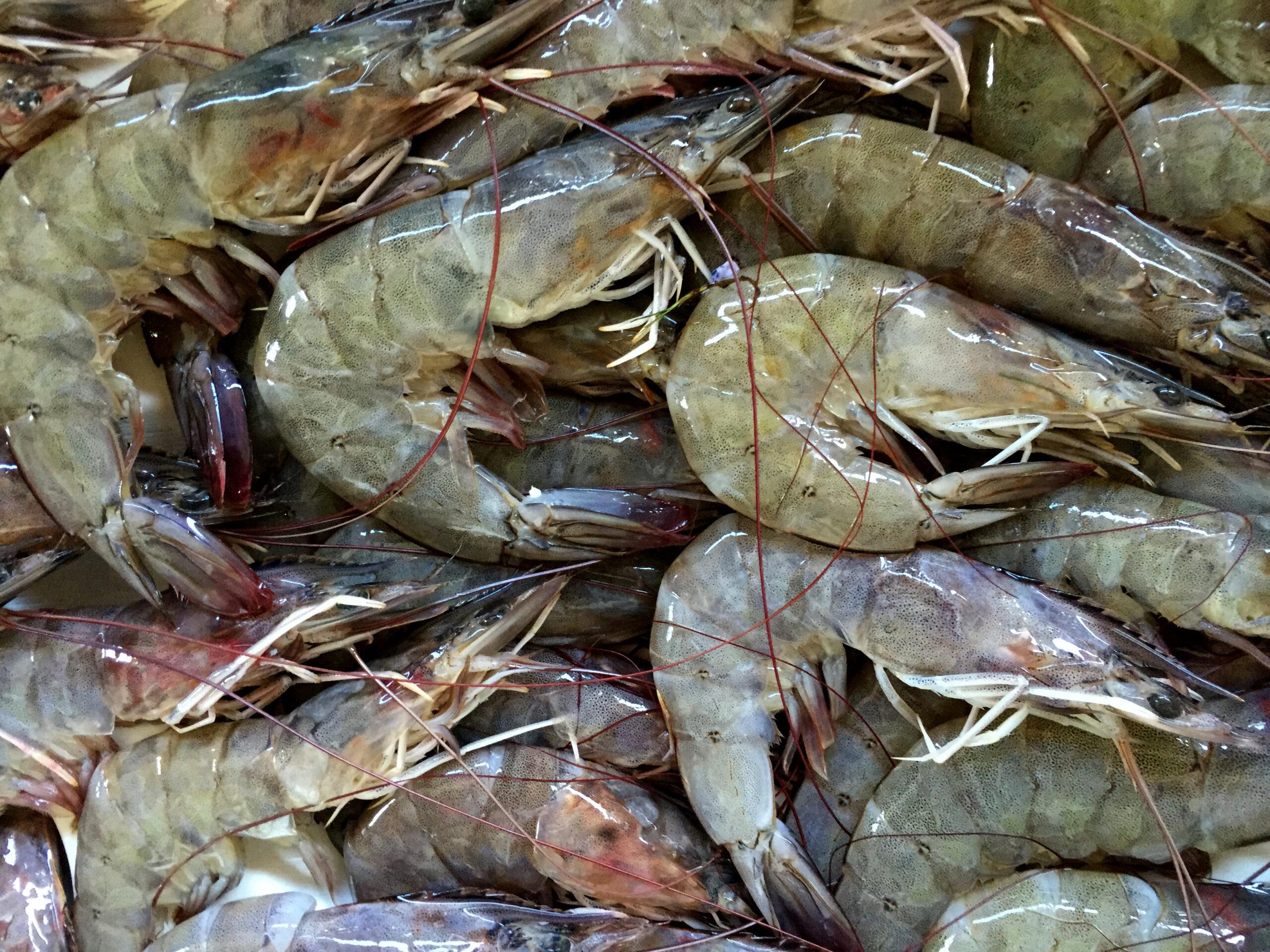
Competitiveness of Philippine Shrimp Industry under the ASEAN Economic Community
The study indicated that Philippine shrimp production, specifically white shrimp and black tiger prawn, shows high competitiveness in an export trade scenario. This means that white shrimp and black tiger prawn are competitive internationally and have potential to earn foreign exchange as export commodities. The study also showed that white shrimp and black tiger prawn are competitive in the import substitution scenario, meaning they have cheaper production cost locally, therefore can compete with imported commodities.
Reference(s):
Andal, E. G., Lapiña, G. F., Manalo, N. Q., Dorado, R. A. Valientes, R. M., & Cruz, M. B. (2017). ASEAN Economic Community: Opportunities and Challenges for the Agriculture, Fishery, and Forestry Sectors. Los Baños, Laguna, Philippines: Philippine Council for Agriculture, Aquatic and Natural Resources Research and Development – (Project Report)



